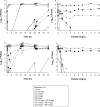Polymyxin combinations: pharmacokinetics and pharmacodynamics for rationale use
- PMID: 25630411
- PMCID: PMC5215892
- DOI: 10.1002/phar.1537
Polymyxin combinations: pharmacokinetics and pharmacodynamics for rationale use
Abstract
Since their reintroduction into the clinic in the 1980s, the polymyxin antibiotics colistin-administered intravenously as an inactive prodrug, colistin methanesulfonate (CMS)-and polymyxin B have assumed an important role as salvage therapy for otherwise untreatable gram-negative infections. However, the emerging pharmacodynamic and pharmacokinetic data on CMS/colistin and polymyxin B indicate that polymyxin monotherapy is unlikely to generate plasma concentrations that are reliably efficacious. Additionally, regrowth and the emergence of resistance with monotherapy are commonly reported even when concentrations exceed those achieved clinically. Given this situation, polymyxin combination therapy, which is increasingly being used clinically, has been suggested as a possible means of increasing antimicrobial activity and reducing the development of resistance. Although considerable in vitro data support this view, investigations of polymyxin combination therapy in patients have only recently commenced. The currently available clinical data for polymyxin combinations are generally limited to retrospective analyses and small, low-powered, prospective studies using traditional dosage regimens that achieve low plasma concentrations. Considering the potential for rapid development of resistance to polymyxins, well-designed clinical trials that include higher-dose polymyxin regimens are urgently required to provide a more definitive answer regarding the role of polymyxin combination therapy compared with monotherapy. In this article, we provide an overview of key in vitro and clinical investigations examining CMS/colistin and polymyxin B combination therapy.
Keywords: colistin; colistin methanesulfonate; combination; polymyxin B; polymyxins.
© 2015 Pharmacotherapy Publications, Inc.
Figures




Similar articles
-
Rational Combinations of Polymyxins with Other Antibiotics.Adv Exp Med Biol. 2019;1145:251-288. doi: 10.1007/978-3-030-16373-0_16. Adv Exp Med Biol. 2019. PMID: 31364082 Review.
-
To B or not to B, that is the question: is it time to replace colistin with polymyxin B?Pharmacotherapy. 2015 Jan;35(1):17-21. doi: 10.1002/phar.1510. Epub 2014 Oct 24. Pharmacotherapy. 2015. PMID: 25346395 Review.
-
Clinical Pharmacokinetics, Pharmacodynamics and Toxicodynamics of Polymyxins: Implications for Therapeutic Use.Adv Exp Med Biol. 2019;1145:219-249. doi: 10.1007/978-3-030-16373-0_15. Adv Exp Med Biol. 2019. PMID: 31364081 Review.
-
Pharmacokinetics and pharmacodynamics of 'old' polymyxins: what is new?Diagn Microbiol Infect Dis. 2012 Nov;74(3):213-23. doi: 10.1016/j.diagmicrobio.2012.07.010. Epub 2012 Sep 6. Diagn Microbiol Infect Dis. 2012. PMID: 22959816 Free PMC article. Review.
-
Pharmacokinetics/pharmacodynamics of colistin and polymyxin B: are we there yet?Int J Antimicrob Agents. 2016 Dec;48(6):592-597. doi: 10.1016/j.ijantimicag.2016.09.010. Epub 2016 Oct 18. Int J Antimicrob Agents. 2016. PMID: 27793510 Free PMC article. Review.
Cited by
-
A Breath of Fresh Air in the Fog of Antimicrobial Resistance: Inhaled Polymyxins for Gram-Negative Pneumonia.Antibiotics (Basel). 2019 Mar 16;8(1):27. doi: 10.3390/antibiotics8010027. Antibiotics (Basel). 2019. PMID: 30884839 Free PMC article. Review.
-
Effect of the meropenem MIC on the killing activity of meropenem and polymyxin B in combination against KPC-producing Klebsiella pneumoniae.J Antibiot (Tokyo). 2017 Aug;70(9):974-978. doi: 10.1038/ja.2017.73. Epub 2017 Jul 5. J Antibiot (Tokyo). 2017. PMID: 28676713 No abstract available.
-
Pharmacokinetic-pharmacodynamic modelling to investigate in vitro synergy between colistin and fusidic acid against MDR Acinetobacter baumannii.J Antimicrob Chemother. 2019 Apr 1;74(4):961-969. doi: 10.1093/jac/dky524. J Antimicrob Chemother. 2019. PMID: 30624656 Free PMC article.
-
Human kidney on a chip assessment of polymyxin antibiotic nephrotoxicity.JCI Insight. 2018 Dec 20;3(24):e123673. doi: 10.1172/jci.insight.123673. JCI Insight. 2018. PMID: 30568031 Free PMC article.
-
Differences in Colistin Administration and Bacterial and Treatment Outcomes in Critically Ill Patients.Sci Rep. 2019 Jun 19;9(1):8781. doi: 10.1038/s41598-019-44965-y. Sci Rep. 2019. PMID: 31217523 Free PMC article.
References
-
- Koch-Weser J, Sidel VW, Federman EB, Kanarek P, Finer DC, Eaton AE. Adverse effects of sodium colistimethate. Manifestations and specific reaction rates during 317 courses of therapy. Ann Intern Med. 1970;72:857–68. - PubMed
-
- Yow EM, Moyer JH. Toxicity of polymyxin B. II. Human studies with particular reference to evaluation of renal function. AMA Arch Intern Med. 1953;92:248–57. - PubMed
-
- Walker B, Barrett S, Polasky S, et al. Environment. Looming global-scale failures and missing institutions. Science. 2009;325:1345–6. - PubMed
-
- World Health Organization. Antimicrobial resistance: global report on surveillance 2014. Geneva, Switzerland: World Health Organization; 2014.
Publication types
MeSH terms
Substances
Grants and funding
LinkOut - more resources
Full Text Sources
Other Literature Sources
Medical

